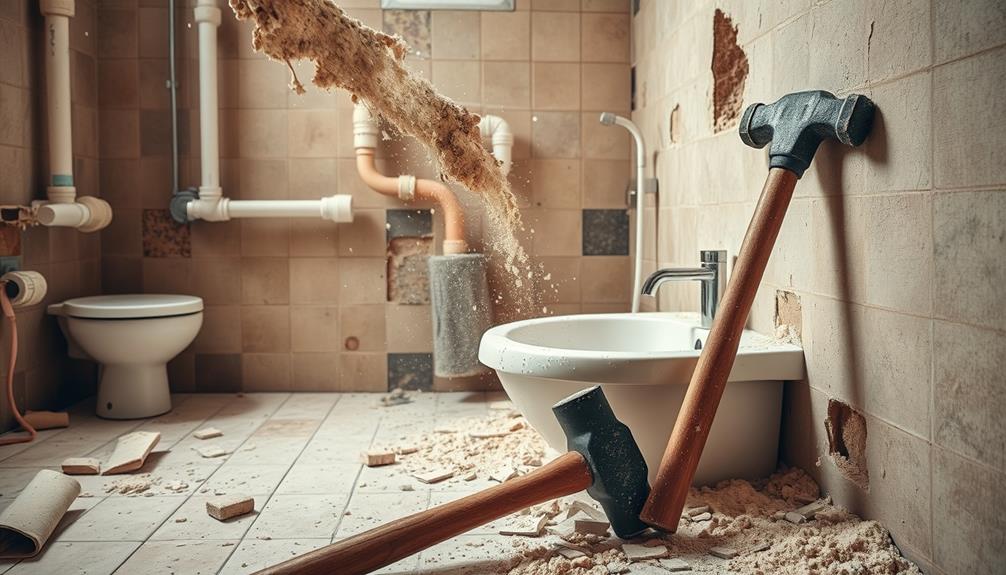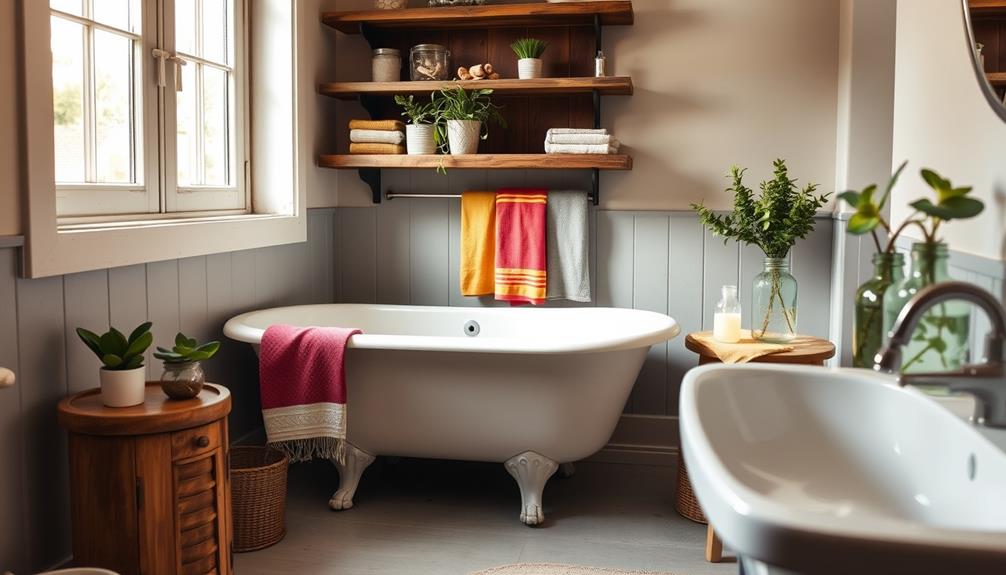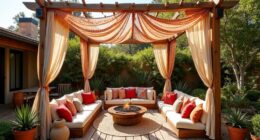When planning your bathroom renovation, start by assessing your needs and goals. Consider your daily routine and prioritize essential features such as storage and fixtures. Look into design ideas that match your personal style, whether it’s luxurious or farm-inspired. Establish a reasonable budget and select durable materials. Efficiently plan your layout and discuss your ideas with a contractor to ensure feasibility. Remember to coordinate the demolition and installation smoothly. Enhance the space with personal touches like decorations and plants for a cozy atmosphere. Continue to explore ways to enhance your bathroom with creative design choices and practical solutions.
Key Takeaways
- Assess your needs and goals, focusing on storage, layout, and budget to ensure functionality and practicality in your remodel.
- Explore design concepts that incorporate luxurious features, natural materials, and proper lighting to enhance aesthetics and create a relaxing atmosphere.
- Set a realistic budget, prioritizing non-negotiable features while exploring cost-effective materials to balance quality and affordability.
- Coordinate with contractors for plumbing feasibility, and ensure compliance with local building codes during the planning and demolition phases.
- Personalize your space with decor items and plants that reflect your style while maintaining a cohesive look throughout the bathroom.
Assessing Your Bathroom Essentials
When planning your bathroom remodel, evaluating your essentials is key to creating a space that truly works for you. Start by reviewing your individual needs, focusing on storage requirements and fixture usage. This step is vital for optimizing the layout of a small space, ensuring every inch is functional.
Think about what you use daily and how you can make those items easily accessible. Exploring your personal tastes can also reveal unique design preferences that enhance your bathroom's overall atmosphere, as noted in finding your design style.
Next, consider how current design trends can influence your choices. Spa-inspired designs and eco-friendly materials can enhance both style and comfort, making your bathroom a more inviting retreat.
However, don't forget practicality; the essentials you select should meet your daily demands while still looking great.
Utilizing space optimization strategies, like wall-mounted vanities or multi-functional furniture, can greatly elevate the usability of your bathroom. These solutions not only maximize your small space but also enhance the overall aesthetic of your bathroom renovation.
Exploring Design Concepts

When you're exploring design concepts for your bathroom remodel, consider the luxurious features of a master bath.
Imagine freestanding tubs and spacious walk-in showers that create a relaxing oasis in your home. Incorporating spa-inspired elements can further enhance this space, promoting tranquility with natural materials and soothing colors.
Additionally, incorporating key features of a farmhouse bathroom can add charm and functionality.
Master Bath Features
Master baths are the epitome of luxury and practicality, seamlessly blending comfort with functionality. When designing your master bath, consider incorporating features that elevate both style and usability. Freestanding tubs and spacious showers create a serene atmosphere, turning your bathroom into a personal retreat.
To guarantee a relaxing environment, consider using well-draining soil for any indoor plants that may enhance the space, as they can contribute to a calming atmosphere through their natural beauty.
One popular trend is the use of spa-inspired designs that focus on relaxation and tranquility. These designs often incorporate natural materials and soothing color palettes, making your space feel more inviting.
To improve the ambiance, don't underestimate the power of expert lighting solutions. Proper lighting can greatly enhance both the aesthetics and functionality of your master bath.
Additionally, think about integrating dual sinks. This feature not only caters to the needs of couples or families but also maximizes the efficiency of your morning routine.
Customization options are key; built-in storage solutions and personalized amenities can elevate your master bath experience while maintaining a clean, organized look.
Spa-Inspired Elements
How can you transform your bathroom into a spa-like sanctuary? By incorporating spa-inspired elements, you can create a space that promotes relaxation and rejuvenation.
Start by focusing on these key features:
1. Freestanding Tubs: Install a luxurious freestanding tub that invites you to unwind and soak your cares away.
Consider DIY Fire Pit Ideas for outdoor spaces to complement your indoor retreat with a serene atmosphere.
2. Rainfall Showerheads: Upgrade to rainfall showerheads, providing a soothing, gentle cascade of water that mimics a natural shower experience.
3. Neutral Color Palettes: Use soft, neutral color palettes inspired by nature, such as shades of beige, taupe, and soft greens, to evoke a calming atmosphere.
Enhancing your bathroom with natural materials like stone and wood further promotes tranquility.
Dim lighting options, including dimmable fixtures and sconces, can elevate the mood, allowing you to create your desired ambiance.
Don't forget the importance of spa-inspired amenities like heated flooring for extra comfort.
Establishing Remodeling Goals

Establishing clear remodeling goals is essential for a successful bathroom renovation. Begin by identifying the primary purpose of your project. Are you looking to enhance functionality, improve aesthetics, or increase property value? These goals will guide your decisions throughout the process.
Additionally, it's wise to contemplate your budget carefully to avoid financial mistakes to avoid that could derail your plans.
Next, contemplate your family's long-term needs. If you have children or elderly family members, think about how these factors will influence the bathroom design ideas you choose.
Assess your current layout to determine if a simple update will suffice or if a complete redesign is necessary to meet your goals effectively.
Make a list of must-have amenities, like a soaking tub or a double vanity. Prioritizing these features will help focus your design choices and guarantee the final result aligns with your vision.
By keeping your specific objectives in mind, you'll create a functional and beautiful space that suits your lifestyle.
Lastly, remember that having clear goals will streamline your decision-making process, making it easier to envision how each element of your bathroom remodeling project contributes to your overall vision.
Budgeting for Your Renovation

Budgeting for your bathroom renovation can feel overwhelming, but it's essential for keeping your project on track. Knowing how to allocate funds properly can make all the difference in achieving your dream bath remodel without breaking the bank.
Additionally, just as the presence of security systems deters potential burglars, investing in quality materials can prevent future repair costs and enhance your home's value.
Here's a quick guide to help you navigate budgeting for your renovation:
- Identify Key Features: Determine which elements are non-negotiable, like quality plumbing work or a stylish vanity.
- Establish a Realistic Budget: Remember that surface makeovers can cost several thousand dollars, while mid-level remodels typically range from $15,000 to $18,000.
- Explore Alternatives: Look for budget-friendly options that don't compromise style, such as choosing less expensive fixtures or materials.
Selecting Quality Materials

Once you've set your budget, the next step is selecting quality materials that will enhance both the look and longevity of your bathroom. Start by focusing on waterproof and durable options. For instance, consider incorporating natural elements like essential oils for a calming atmosphere, such as essential oils for hair growth that can promote relaxation during your bathing experience.
Ceramic or porcelain tiles are excellent choices for your bathroom floor and tile work, as they resist moisture and wear over time.
Don't forget to assess the quality and sustainability of your materials. Research manufacturers and opt for eco-friendly options like low-VOC paints and recycled tiles. For added protection, consider using a waterproofing membrane, such as RedGard, to safeguard your wall tiles and shower areas from moisture damage.
Safety is key, so choose flooring materials with a high slip resistance rating, especially in wet environments. Ceramic and vinyl options offer both aesthetic appeal and functional benefits.
Lastly, evaluate the cost-effectiveness of your materials. Understand typical price ranges to guarantee you balance quality and budget effectively, maximizing the long-term value of your remodel.
Planning and Vision Development

When initiating a bathroom remodel, taking the time to plan and develop a clear vision is essential for achieving your desired outcome. Start by evaluating your current bathroom layout to identify necessary changes, like adding a stylish bathroom vanity or a luxurious walk-in shower. Consulting with a general contractor helps determine the feasibility of plumbing changes and guarantees your design stays practical and compliant with codes. To gather inspiration for your bathroom redesign, consider looking at home improvement magazines or browsing through online design galleries. Incorporating elements such as modern fixtures, a soothing color palette, and efficient lighting can help elevate the ambiance of the space. Don’t be afraid to explore different textures and materials to add depth and visual interest to your bathroom redesign ideas. Remember, the more carefully you plan, the smoother your remodel will go.
Additionally, consider incorporating features that enhance cleanliness and maintenance, such as easy-to-clean surfaces or efficient cleaning tools like best vacuums for dust removal to keep your bathroom fresh and tidy.
To clarify your vision, consider these key aspects:
- Functionality: Think about how you use the space and what features are essential for your lifestyle.
- Aesthetics: Visualize the colors, materials, and styles that resonate with you and create an inviting atmosphere.
- Budget: Set a realistic budget that allows for your desired features without overspending.
Sketching your ideal bathroom design can help you communicate your ideas effectively with contractors. This rough draft not only visualizes potential changes but also facilitates discussions, allowing for adjustments based on their professional insights.
Keep your vision clear, and you'll guarantee a successful remodel that transforms your bathroom into a space you love.
Demolition and Preparation Steps

Before you start tearing down walls, make certain you've got a plan for temporary bathroom solutions to keep things running smoothly.
Consider researching the importance of fuel injection cleaning for vehicle performance as you may need reliable transportation during your remodel.
You'll need to secure any necessary inspections and permits to stay compliant with local building codes, so don't skip that step.
Coordinating demolition with your contractors will help guarantee everything goes off without a hitch and keeps your project on track.
Temporary Bathroom Solutions
Planning for temporary bathroom solutions is essential to minimize disruption during your remodel. Before you engage in demolition, consider your alternative bathroom arrangements. You might need to set up a temporary shower or use a different bathroom entirely.
Additionally, it's helpful to think about cold medications overview you might need if any family members catch a cold due to the construction dust. Here's a quick list to help you prepare:
- Identify Alternative Facilities: Know where your nearest bathroom is, and inform your family or housemates about the changes.
- Set Up a Temporary Shower: If you're tackling the shower area, invest in a portable shower setup. It'll keep you clean and comfortable.
- Communicate with Neighbors: If shared facilities are involved, let your neighbors know what to expect. It'll foster goodwill and understanding during the renovation.
Don't forget to schedule necessary plumbing inspections before starting demolition. Ensuring compliance with local building codes is critical to avoid future headaches.
As you prep the area, remember to install a PVC waterproof barrier to protect against water damage. This way, you'll have a smooth shift to the installation phase once all inspections are completed.
Inspection and Permits
Starting a bathroom remodel requires careful attention to inspections and permits to confirm your project adheres to local building codes. Before you begin, make certain to schedule the necessary inspections and obtain the required permits from local authorities. This step is essential to avoid costly delays later on.
Consult with your general contractor to navigate the permit process effectively. They can help you understand what's needed for your specific remodel, making sure you comply with all regulations.
Proper planning during demolition is critical; consider how you'll manage without a functional bathroom, and arrange alternative restroom options for your household.
As you prepare for demolition, sequence the removal and installation processes to align with inspection requirements. This coordination will help keep your project on track. If your remodel involves installations like PVC waterproof barriers or cement grading for drainage, confirm meticulous preparation to meet safety standards.
Lastly, maintain open communication with your contractor and, if necessary, your neighbors regarding shared facilities. This approach will foster goodwill and minimize disruption during your remodel.
With these steps, you'll set a solid foundation for a successful bathroom renovation.
Efficient Demolition Coordination
Efficient demolition coordination is key to a successful bathroom remodel, guaranteeing that you minimize downtime and streamline the renovation process. To make this phase smooth, follow these essential steps:
- Plan for Alternatives: Before demolition, arrange temporary shower and restroom options. This keeps your household running smoothly during the remodel.
- Schedule Inspections: Get necessary approvals for plumbing and electrical work. Complying with local building codes can save you from costly delays.
- Coordinate with Contractors: Work closely with your contractors to establish a sequence of tasks that aligns with inspection requirements and guarantees an efficient demolition process.
Additionally, keep communication open with neighbors, especially if shared facilities are impacted. This fosters goodwill and sets realistic expectations.
Before tiling, don't forget to create a proper PVC waterproof barrier for your shower enclosure and manually grade the cement to guide water flow toward the drain.
Tiling and Installation Tips

When it comes to tiling your bathroom, using smaller tiles for shower floors is a smart choice. These small tiles effectively accommodate the necessary drainage gradient and provide a non-slip surface, essential for wet areas.
To enhance moisture protection, apply a RedGard waterproofing membrane to your wall tiles, ensuring a barrier against leaks.
For the tiling process, use thin-set mortar mixed consistently and applied quickly. This helps avoid issues during installation, especially with larger format tiles, which often require two people for safe handling and cutting.
Grouting comes after tiling; it fills gaps and gives your work a polished, finished look. Be sure to confirm the placement of fixtures according to your selected finishes and plumbing requirements.
Final Touches and Personalization

To truly transform your bathroom into a personal sanctuary, focus on the final touches that reflect your style. This is where you can infuse your personality into the space. Consider these key elements:
- Decor Items: Select rugs, mirrors, and faucets that resonate with your aesthetic. These pieces aren't just functional; they also elevate the overall vibe of your bathroom.
- Personal Touches: Incorporate unique artwork or heirloom pieces. These items create warmth and an inviting atmosphere, making the space feel truly yours.
- Smart Devices: Enhance your bathroom's functionality with automated lighting and temperature controls. This modern touch can make your daily routine more enjoyable and efficient.
Don't forget about the power of color. Complete your painting after all major installations to guarantee a flawless finish.
If you're looking for a fresh, natural element, consider adding living plants that thrive in low-light conditions.
Frequently Asked Questions
Is There an App That Lets You Design a Bathroom?
Yes, there's an app called RoomSketcher that lets you design your bathroom. You can easily create 2D and 3D floor plans, drag-and-drop fixtures, and visualize your ideas with various angles for a perfect layout.
In What Order Should You Renovate a Bathroom?
When you renovate a bathroom, start with planning and permits. Next, demolish existing features, then install plumbing and electrical systems. Follow with tiling and flooring, finishing with painting and fixture installations for a complete transformation.
What Are the Rules of Bathroom Layout?
Imagine a well-choreographed dance; your bathroom layout should keep toilet, sink, and shower close, ensuring 30 inches of clear space. Prioritize plumbing walls and consider natural light for an inviting, functional space.
How to Decide on Bathroom Design?
To decide on your bathroom design, start by defining its purpose and your needs. Prioritize functionality and storage, explore current trends, and visualize your ideas using design tools to guarantee a perfect fit for your lifestyle.
Conclusion
As you wrap up your bathroom remodel journey, remember that every detail counts. You've transformed not just a space but also how you experience home. By blending functionality with personal style, you've created a sanctuary that reflects you. So, as you step into your new bathroom, take a moment to appreciate your hard work—after all, isn't it the little things that make the biggest impact? Embrace your space and enjoy the comfort it brings.









